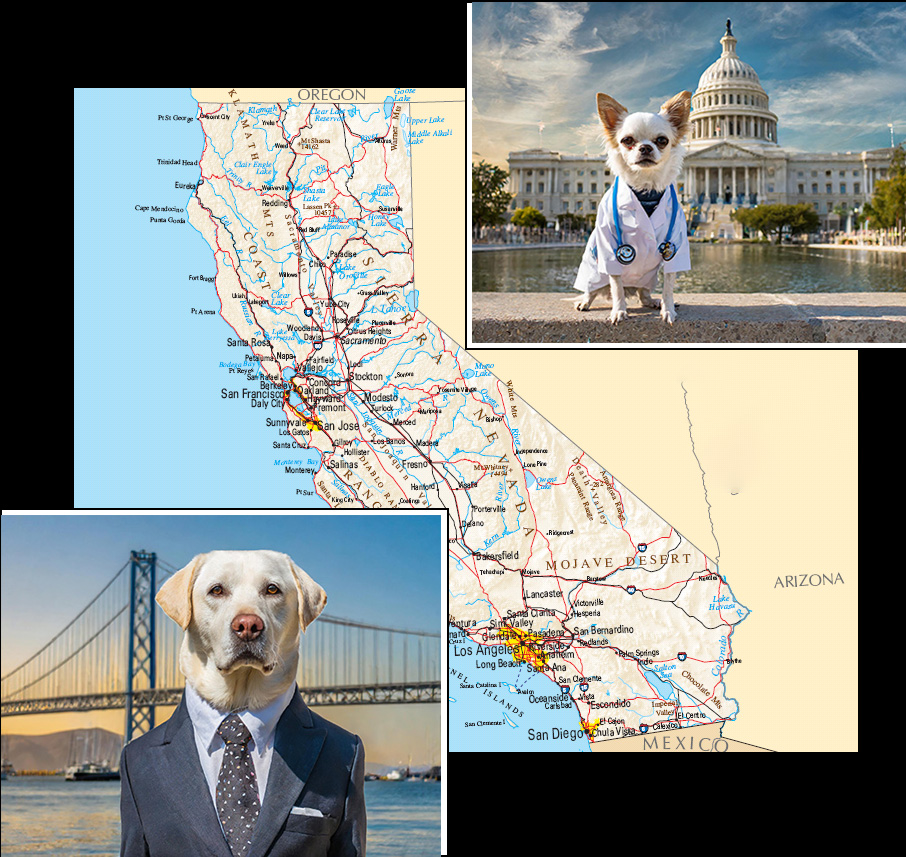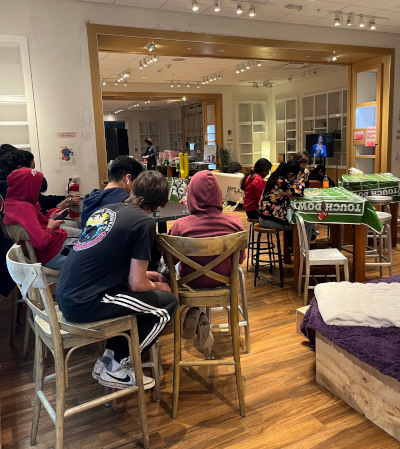Blog
Alcohol Justice's Best and Worst of 2023: WORLDWIDE
 Indefatigable watchdogs Buster (angry) and Sergio (stoked) rate last year's major developments in the California alcohol landscape.
Indefatigable watchdogs Buster (angry) and Sergio (stoked) rate last year's major developments in the California alcohol landscape.
Sergio prevents; Buster just vents.
—
Your Childhood, But Alcoholic
The past year marked a true explosion in alcoholic products carrying established non-alcoholic brands. From Coca-Cola to SunnyD to Dunkin Donuts, the alcohol industry doubled down on the concept of “take your childhood, and get you drunk with it.” While the category is loose—sometimes collapsed with hard seltzers and/or ready-to-drink cocktails—market research firm Precedence Research estimated a market size of $16.75 billion in 2023, an increase of as much as 60% in two years.
That market may not be completely legal. These products do not just prey on adult drinkers’ nostalgia for youth, they employ branding readily identifiable by actual youth. They already boast the attributes necessary to introduce alcohol to someone without a taste for it—heavily sweetened, heavily flavored, sold in single-use containers. Watchdog groups have long been calling foul over alcopops, heavily-flavored malt beverages sold in packaging reminiscent of sodas, energy drinks, and other youth-friendly products. What they did not expect was that, rather than reform the product lines, the industry would simply do away with the “reminiscent.”
Already regulators are trying to pass laws preventing sodas and their alcoholic cousins from being sold in close proximity, to limit accidental purchase. But Buster warns us that the threat is more deepset than mistaken identity. Instead, any product at all that youth grow attached to will be used to encourage them to start drinking an alcohol-spiked echo.
—
In Myanmar, Brands Fund Genocide With Juice
Alcohol Justice joined an international movement led by Amnesty International to push Kirin, a Japan-based international megabrewer, to end partnerships with Myanmar’s army. Rather than merely doing private business in the country, Kirin’s production license piped revenue directly at specific army units, units that were heavily implicated in genocidal actions against the Muslim Rohingya minority on the Bangladeshi border. In 2022, Kirin withdrew from Myanmar.
That was far from the final victory, however. In November 2023, a report from Justice For Myanmar, via Movendi International, showed that Big Alcohol continues to flood the coffers of violent actors in the country. Tax documents show that Heineken, Carlsberg, and ThaiBev combined to directly channel $27.6 million to the junta via goods taxes, though the total may be as high as $155 million. Despite renewed vigilance from the international community, the Myanmar military, which came to power in a 2021 coup, continues to perpetrate violence against dissidents. Despite the withdrawal of most major international companies following the coup, these three brewers struck deals with an oligarchic local family to keep the taps open.
Alcohol’s profitability lies at the heart of most of its sellers worst behaviors. But Big Alcohol’s eagerness to ally with violent leadership immediately after being internationally shamed for doing that same thing is contemptible.
—
Bud Light Throws Trans Model Under the Bus

The surreal anger over Bud Light’s use of transgender TikTok influencer Dylan Mulvaney may have simmered down. (It also may have not, since Presidential candidate Donald Trump has been publicly calling for reactionary followers to “forgive” Bud Light producer Anheuser-Busch InBev [ABI]—and Buster cannot imagine a scenario in which he was not paid to do this.) But by all indications, it left Mulvaney herself high and dry.
The campaign was simple: Bud Light sent Mulvaney a few cases, including a can with her face printed on it. The backlash was possibly even more simple: conservative culture warriors called for a boycott of Bud Light, and their followers responded in an extremely normal and proportional manner. But the consequence for Mulvaney herself seems to have been horrifying, including stalking and death threats. Most tellingly, after the campaign backfired, she never heard from ABI executives again. Not to apologize, not to check in, not even to formally retract their endorsement.
The reason for bringing in Mulvaney is, again, simple. She is an influencer, with over 10 million followers on TikTok, the video-centric social networking site that draws a younger demographic. And trans rights advocacy is much higher among younger age groups, with 47% of 18 to 29-year-olds saying trans acceptance had not gone far enough, compared to 36% of the population in general. According to the New York Times, Alissa Heinerschied, the VP of Marketing for Bud Light, declared the brand was “in decline” because of the lack of young drinkers. So Mulvaney was clearly tapped to bring young (and, in some cases, likely too young) drinkers around to the product.
Instead, it blew up Bud Light’s market share and Dylan Mulvaney’s life. But as things stand now, 18-29 year-olds are drinking far less than the generations before them. The kids really do seem to be alright.
—
Industry Ringers Make a MACH-ery of Healthy Drinking Standards

Every five years, the United States Department of Agriculture (USDA) releases new standards for nutrition and healthy eating behaviors. These standards are determined by seating a number of significant experts in each nutritional category, and asking them to review the existing evidence and make a recommendation. Along with nutrients and sugars, suggested alcohol consumption levels are determined through this process. And the USDA may have reached out to the single least trustworthy experts in the country.
In 2018, the National Institute on Alcohol Abuse and Alcoholism (NIAAA) announced a new study that would deliver measured quantities of alcohol to participants to determine the health outcomes. The study was a mess from the start: it was largely funded through alcohol industry grants, the outcomes were engineered to hide a number of long-term outcomes, the participants were selected in such a way as to quash detectable harms, and, most tellingly, the scientists conducting the study had been in a long-term communication with the alcohol industry prior to the launch of the project.
According to principles of ethical research, this should have discredited these researchers in the long term, but carrying industry water comes with certain perks, professional resilience among them. When the makeup of the panel conducting the initial round of review for the USDA guidelines (performed through the affiliated but nongovernmental National Academies of Science, Engineering, and Medicine) was announced, it featured Dr. Kenneth Mukamal and Dr Eric Rimm—researchers behind the corrupt “safe drinking” study.
In the face of professional outcry from across the alcohol research community and a blown whistle from the New York Times, the two were removed from the panel. But the fact remained: absent constant watchdogging (Buster’s tail is wagging), unethical research behavior in service of Big Alcohol gets rewarded.
—
Industry Clouds EU Eyes

The United States is not the only body having difficulty properly acknowledging the state of the science around alcohol consumption. In late December, the public health subcommittee of the Parliament of the European Union (EU) authorized a report on noncommunicable diseases. Noncommunicable diseases, or NCDs, comprise causes of morbidity and mortality that derive, not from infection or accidental injury, but from the kinds of behaviors only possible in our modern world. The majority of these are actively aggravated by commercial entities—including the alcohol industry.
The report had serious shortcomings when it came to alcohol: it suggested that the harms of alcohol only accumulated to people who drank in a harmful manner. To further drive that point home, it called for alcohol labels to include information on “moderate and responsible drinking,” an industry catchphrase used to hide truthful information on alcohol impact. To push back against this, Eurocare—backing a minority of members of parliament—pushed the following recommendations:
1. Recognising the Full Impact of Alcohol: The WHO European Region faces the highest level of alcohol consumption globally, leading to substantial health, economic, and social burdens. The current SANT report draft fails to address this
2. Challenging Industry Influence: The alcohol industry's lobbying efforts have led to worsened alcohol-related sections in the report. This undermines the effectiveness of policies aimed at preventing and reducing alcohol
3. Advocating for Clear Labelling and Public Awareness: There is a vital need for mandatory health warnings and full ingredient listings on alcohol products, in line with the goals of the Europe's Beating Cancer
4. Promoting Evidence-Based Policies: We urge MEPs to thoroughly fight any language that contradicts scientific evidence on the adverse health implications of alcohol
5. Strengthening EU Alcohol Strategy: A renewed commitment from the European Commission is needed to ensure transparent, evidence-based messaging on alcohol consumption, aligning with the EBCP and broader EU public health.”
As one would imagine, these recommendations were passed over and the report authorized as is.
The refusal to acknowledge of the state of the science has been plaguing public health across multiple domains. But the most recent disappointment comes hot on the heels of the COVID-19 disaster and the enormous upswing in alcohol harm that followed. You can’t fight noncommunicable diseases without communication.
—MLB Owners Rush Drunk Fans Into Their Cars

The 2022 and 2023 baseball seasons saw a bevy of rule changes intended to slow down the traditionally staid and stately pace of the game. Many of these measures were successful (though we would not hesitate to sic Sergio, normally a good dog, on the extra-innings “zombie runner”), leading to… well… shorter games.
The seventh inning stretch is a universal tradition in ballparks, and for decades has heralded the end of the alcohol sales for the game. The reasoning was simple: give fans a couple innings to sober up. Do not let them hop behind the wheel with blood, adrenaline, and alcohol pumping through their veins. (This likely reduced chaos during nailbiting or devastating 9th innings.) But in the past 20 years, nearly every kind of entertainment has leaned whole-heartedly into alcohol revenue to boost earnings.
Baseball was no exception, and this made the shortened games threaten the amount of revenue ownership could rake in at the gate. As flagged by Phillies long reliever Matt Strahm, some teams responded by doing away with the alcohol sales cutoff. While the seventh inning limit was not the great protective measure professional athletics need—limiting alcohol money and marketing would likely be the most impactful way to reduce alcohol harm—it underlines owners’ basic loyalty: to the dollar, not the fans. And not to Sergio.
—
Point 05 Hits the Interstate

Across most of high-income countries, the legal threshold of blood alcohol for dangerous driving falls at or below a 0.05% concentration. Most of the United States, however, stubbornly clings to 0.08%, both out of fear of industry backlash and because of a national resistance to any new public health-oriented legislation.
The one state bucking the trend is Utah, which instituted the world 0.05% standard in 2019. The subsequent results were dramatic. According to the National Highway Traffic Safety Administration, fatal crash rates dropped 19.8%, and more than 1 in every 5 Utahans who drank alcohol reported changing their behaviors in response to the law.
Other states, including California, have toyed with introducing this lower limit since. This past year saw four separate states advancing the proposal. None managed to get it to the Governor’s desk, but every attempt lowers the bar to get it done.
—
How Dry the Grey Lady Is

Love it or hate it, the New York Times remains the United States’ paper of record. And in 2023, the paper started paying real attention to flood of alcohol harm throughout the country. Perhaps the pinnacle fo this coverage came in May, when its video team released a powerful and engaging video piece raising a powerful, simple, and usually popular solution to runaway alcohol morbidity: raise the excise taxes.
The piece, “A Toast to Raising Alcohol Taxes,” made the simple and powerful point that the cheapest prices for booze and the most income for producers leads to increased consumption, especially among lower-income and higher-consuming individuals. And as the piece de resistance, the website’s vox pop shows viewers supported raising taxes by a 72% to 28% margin. (The selection bias for respondents is obvious, of course, but so is the fact that the paper is now interested in courting people for whom alcohol policy is a concern.)
The more mainstream outlets channel common-sense alcohol control strategies to the public, the more the constant bowing to industry pressure seems like a series of missed opportunities. While it’s true that no news is good news, Sergio’s Corollary holds that a good editorial is great press.
—
ABV-Pegged Tax Blamed for Making People Healthier

The vast majority of United States alcohol taxes take the form of a set rate per volume of product put on shelves. That is to say, all beers are taxed a one rate, all wines at another, all distilled spirits at a third. Yet this schema starts seeming ridiculous once producers “innovate” with extremely strong products in their category. A 12% ABV beer is equivalent in strength to a 24-proof spirit, yet normally sold in a single-serving, non-resealable container, and taxed in the lowest excise bracket. However, in terms of how much alcohol the consumer has, how much damage their body takes, and how much risk to others emerge from their drinking that amount, the cost of the two products is identical.
With this reasoning in mind, the United Kingdom launched into an overhaul of its tax system. While it did not adopt a true graduated ABV tax, it set dual thresholds where low-ABV products (under 3.5%) get a relative tax break, while all products over 8.5% ABV are taxed at an often higher level. (Because the previous, fragmented-by-product system was so ad hoc, a minority of wines actually got cheaper—but for the most part this new schema hits high-potency beers and wines much harder.)
The result? A surge in reduced ABV beer, ostensibly to take advantage of the lower brackets. Outlets like the Daily Mail, who traffic in government skepticism, labelled the effect “drinkflation,” but the impact is more straightforward than that: moderation.
—
Ireland Brings the Warning Label Into the 21st Century

Alcohol warning labels are a ubiquitous part of the packaging.
They are also nearly worthless.
Cramped, uninformative, vaguely hectoring yet also hyperspecific, the cramped cautions not to drink while pregnant or operating a forklift likely do little to change behavior if they are even seen. Yet burgeoning research shows they can be impactful. Alcohol’s influence on cancer rates is poorly understood by the public, and a Canadian study found that bold, colorful, and concisely educational labels not only increase awareness of this risk but lower purchasing overall.
On top of this, alcoholic products have long been exempted from ingredient disclosure laws. Allergens or other problematic ingredients are not disclosed, and the constant industry refrain of “drink responsibly” is time and time again undermine by lack of information about just how many standard drinks are in any given container. Even something as simple as calorie count is left off the label, unless of course the producer thinks they can sell more bottle by slapping it on.
The strong industry resistance to a reformed alcohol label already torpedoed previous efforts. But Ireland, looking at high levels of alcohol-related harm paired with low-levels of risk awareness, plowed ahead with the boldest reform to date. Signed into law in May of 2023, the Irish labelling regulations mandate large red-print labels that provide both health and content information in a high-contrast, easy to read location prominently placed on the back of the bottle. According to The Lancet, the warnings would foreground three messages: "drinking alcohol causes liver disease;" "there is a direct link between alcohol and fatal cancers;" and a graphical icon meant to warn against drinking while pregnant.
The industry lashed out, deriding the policy as “anti-European,” but so far it has been upheld at the EU level. Threats to nullify it through U.S. trade interventions have so far likewise not resulted in the labels' withdrawalwithdrawal. However, the actual labels are not required to be present until 2026, and Sergio and the entire advocacy community should be on guard against efforts to strike it from the books. After all, knowledge saves lives, and even dogs get tired of burying bones.
—
From CAPA and Alcohol Justice: thank you, advocates, allies, and those who care, for your tireless work in 2023 and every year.
—
READ MORE about the Best and Worst of 2023: IN CALIFORNIA
Alcohol Justice's Best and Worst of 2023: CALIFORNIA
 Indefatigable watchdogs Buster (angry) and Sergio (stoked) rate last year's major developments in the California alcohol landscape.
Indefatigable watchdogs Buster (angry) and Sergio (stoked) rate last year's major developments in the California alcohol landscape.
Sergio prevents; Buster just vents.
—
The Indefinite Extension of Regulatory Relief 
How soon we forget.
When the COVID-19 outbreak started spreading in California in March of 2020, Governor Newsom issued a stay-at-home order that severely restricted public gathering places, notably including restaurants and bars. To offset this, the California Department of Alcoholic Beverage Control issued a number of “regulatory relief” orders, allowing these retailers newfound privileges to access delivery, serve as alcohol takeaway outlets, and expand their serving capacity beyond that allowed in the license. These orders, California residents were assured, would only last so long as the emergency order was in place.
Since then, however, Gov. Newsom and the legislature have extended nearly all of them, creating a state of “permanent emergency” measures. In 2023, bills to continue the expanded footprints and delivery by post passed (as did a heavily amended bill that would allow greatly expanded outdoor consumption in San Francisco), while bills intended to extend delivery privileges were introduced but stalled—quite possibly because they put too much pressure on delivery companies. This state of eternally extended short-term deregulation comes as California faces shocking increases in alcohol-related death (see below). The hope is that the legislature will wake up to its own role in perpetuating harm, because its currently engaged in a steady, blind downwards spiral.
—
Bud Ads for Undergrads

Alcohol underlies all the leading causes of death for young adults. It plays a significant role in accidents, crashes, homicide, and suicide, and has a synergistic effect on opioids that increase overdose risk. Moreover, alcohol is involved in a number of outcomes that derail educational careers, including violence, sexual assault, and academic difficulties. So, it stunned community health and school safety advocates when self-described education-focused legislator Dawn Addis (D-San Luis Obispo) introduced a bill that would greatly expand the alcohol industry’s ability to advertise on California State University (CSU) campuses.
By stripping away existing bans on advertising in major campus recreational facilities, the bill would raise a nominal amount of money in ad sales. That amount, however, was trivial—less than $1 million, against a debt likely exceeding $8,800 million. Worse, administrators from CSU campuses bragged that these ads would be shown, not just to students at the university, but to elementary school students in the community.
This cruel money-grubbing has happened before; San Diego State university recently expanded its ability to sell ads to Big Alcohol, resulting in one producer branding itself “The Official Vodka of San Diego State” even as the school faced blowback from sexual assault at parties. But Addis’s proposal expands this recklessly across eight additional campuses and creates the template by which Big Alcohol can buy its way into hundreds of thousands of underage students’ daily lives.
—
Governing Under the Influence (GUI)

Do our leaders create a social climate, or do they reflect it? This is not a mere philosophical exercise for folks working to promote public health and safety. Fact of the matter is, alcohol is considerably less tightly regulated now than it was five years ago, and five years ago it was much less tightly regulated than 25 years ago. Our governor, in fact, made his fortune in the alcohol industry. And our legislators have a nasty habit off getting into alcohol-involved scrapes. In 2018, then-Assemblymember Cristina Garcia told KQED, “At some point I’ve had a keg at my office. A lot of us do.” It is not clear who else has that cavalier an attitude towards both alcohol consumption and running an effective workplace, but the fact remains that legislators keep running into deeply concerning alcohol-related trouble.
The past year saw not one but two legislators charged with driving under the influence of alcohol. State Senator David Min and Assemblymember Wendy Carrillo both found themselves facing legal and public scrutiny for dangerous driving. This raises two questions: were either of them capable of drawing a broader connection between the alcohol sales environment and their own decisions to drive when incapacitated, and will either of them adjust their voting record accordingly?
The optimist in us hopes they will, and that something constructive for California will result from their legal entanglements. But Buster knows Min and Carrillo will absolutely not be the last lawmakers embroiled in reckless consumption amidst a disintegrating regulatory environment.
—
Alcohol-Related Mortality Soared in California

California Department of Public Health (CDPH) has the potential to play an outsize role in resetting the agenda for alcohol policy in the state. It is often hesitant to do so, however, whether from political pressure, scant resources, or learned powerlessness. Now, though, hot on the heels of the perpetually temporary deregulation of alcohol, CDPH has launched the Alcohol Harms Prevention Initiative (AHPI), leading with a deeply disturbing report on alcohol mortality in the state.
The modestly titled “Deaths from Excessive Alcohol Use in California” report shows the true breadth of runaway alcohol consumption during the COVID-19 pandemic. Using methods honed by the U.S. Centers for Disease Control and Prevention, the CDPH team estimated 19,335 alcohol-related deaths per year. This is up from 10,811 in 2015, an increase of 79% in under a decade.
The news is bleak and strongly suggests a multitude of regulatory failures, including the abandonment of evidence-based environmental prevention strategies. However, Buster sees reason for optimism: the introduction of the AHPI. CDPH’s embrace of alcohol harm as a priority area adds another deeply needed voice to the fight for compassionate and effective alcohol policy.
—
Alcohol Justice Researchers Uncover Policy Patterns and the Quilt of Harm

There has long been a feeling that the California legislature has been dismantling the protective alcohol regulatory infrastructure for a while now. Feelings, however, are not science. Alcohol Justice researchers combed through every piece of alcohol-related legislation over the past 10 years to see whether this was true, and what areas of protective policy were most under threat.
The findings were stark: alcohol-related legislation rapidly increased, from 52 in the 2013-2014 legislative session to 92 in the 2021-2022 session. Over the ten-year period, of those signed into law, over twice as many bills were out of compliance with World Health Organization best practices. The report went further into exactly what kinds of harmful legislation was most likely to pass, and can be accessed here.
Though the findings were discouraging, our staff were heartened to find Sergio approved of the project and its potential to shine light on out-of-control legislative priorities.
—
A Pro to Head Up Alcoholic Beverage Control

The California Department of Alcoholic Beverage Control (ABC) is far from the sexiest institution in the government. But it is vital, not just in enforcing the alcohol code broadly, but in determining how limited resources are allocated, providing clarity and boundaries around practices that skirt the edge of written law, and serving as the voice of experience on alcohol harm matters within the government. It does not, however, answer only to public health voices; indeed, it often has weighed industry desires in its decisions. For decades, the agency was a black box to public health and safety advocates.
This opacity was lifted in 2018 by its director Jacob Applesmith and his deputy and successor, Eric Hirata. They perpetuated a program of open meetings with community advocates, including organizations within the California Alcohol Policy Alliance (CAPA). However, when Hirata stepped down last year, there was a moment of tension and fear.
The ABC Director is not an open hire. The position is appointed by the Governor, and this always runs the risk of an industry flack stepping into the position, a risk that weighed heavy in light of Newsom’s heavily alcohol-industry-connected background. Fortunately, the Governor acted in the best interests of the state, appointing Joe McCullough to the position. McCullough not only has a long history of service within ABC, but has been a constant, committed, and responsive contributor to the ABC–CAPA relationship. Sergio is excited to work with him, as are we all.
—
Vineyard Workers Overcome Legislative Roadblocks

The myth and ghost of Cesar Chavez is wound tightly into the spirit of California. So, it came as a shock with Gov. Newsom vetoed a plan that would allow California agricultural workers—substantial among them, the individuals tasked with harvesting California’s wine grapes—the opportunity to elect unionized status free of employer interference.
Under previous rules, union elections had to be by ballot on-site at employer worksites, an increasing logistical nightmare as technology, social distancing, and land consolidation dispersed workers further and further across the employer properties. Under the new rules, the workers can elect to join a union by signing cards declaring support, a policy known as “card check”. Winery owner and California Governor Gavin Newsom vetoed the original version of this bill, which would have also allowed vote-by-mail options, but eventually agreed to the card-check only iteration.
On top of the general association between substandard working conditions and overall predatory industry behavior, exploitation has itself historically harmed generations in this state.
And, as Sergio has oftened howled from picket lines, an alcohol-related harm to one is an alcohol-related harm to all.
—
Testing Testing 1-2-3

As far as alcohol risk is concerned, the phenomenon of drink-spiking exists in a indeterminate, overlooked space. Having a drug--normally a sedative/hypnotic like GHB or rohypnol, though any unwanted drug meets the definition—to an unsuspecting victim’s drink is known to happen, although the reported prevalence varies wildly. The practice is most likely a component of attempted sexual assault, although researchers have identified a number of other motives among perpetrators. Moreover, studies have shown it is does not only happen to women. What is well known, however, is that the experience can be deeply traumatic even if the victim experiences nothing more than severe, unplanned intoxication.
The solution is simple, and the California legislature cottoned onto it. In one of the precious few protective bills in 2023, Assemblymembers Josh Lowenthal and Diane Dixon successfully guided AB 1013 onto the Governor's desk. This new law requires all bars to provide, at or near cost, drink testing kits for common adulterants. This policy offers both protection in the short run, and a sense of security for victims in the longer run. In the best possible world, it establishes drink testing as a norm, discouraging spiking from ever happening in the first place.
—
Just the Tax, Ma’am

Time and time again, research has demonstrated that alcohol tax increases are a simple, effective, and publicly popular method to offset alcohol harm. Not only does the price point lead to consumption dropping—and dropping disproportionately among the heaviest drinkers—but the revenue raised can be immediately diverted to fund prevention, treatment, and recovery. Yet the policy remained, and remains, highly politically unpalatable in California, where alcohol taxes have not been raised since 1991. And unlike sales taxes, which are percentages of a total transaction, alcohol-specific excise taxes are fixed amounts per quantity of alcohol produced. That makes that 1991 amount worth less every year; with the inflation of the last couple years, its current value is less than half of what it was the last time it was raised.
But if alcohol taxes do not have friends in the capitol, they seem to have gained some in the press. Along with the New York Times (see WORLDWIDE), influential political newsletter CalMatters published a detailed call for a modernized alcohol excise tax. Drawing on experts including, but not limited to, Alcohol Justice, journalist Dan Walters makes the case that a cash-strapped state should stop blinding itself to the significance of stalled and stale tax levels.
Sergio agrees enthusiastically, although he would like to emphasize that the most effective alcohol tax schemes aren’t per product—they’re set according to alcohol by volume (ABV).
—
CAPA Coast to Coast

The California Alcohol Policy Alliance (CAPA) was founded in the mid-2010s in the wake of the coalition opposing unlicensed alcohol service in bars and salons. Since then, it has become an insistent voice of reason in alcohol policy, and a locus for public health and safety groups throughout the state to focus their energies on rational alcohol policy. At the end of the year, Alcohol Justice likes to take stock of CAPA’s successes. But nothing speaks so loudly to their accomplishments as their integration into even broader groups.
Under new director Raul Verdugo, CAPA has served as a consultant in a number of ongoing alcohol policy fights, including the rapidly snowballing Georgia Alcohol Policy Alliance and the national Alcohol Action Network, intended to bridge researchers and advocates across all states. CAPA also lent its voice to the desperately needed efforts in New Mexico to combat alcohol harm through tax increases and critically needed new services—a legislative battle that continues in 2024.
There are many things to celebrate simply in the organization being able to lend capacity to those fights. But above and beyond all of it is the realization that protecting public health and safety in 2024 will be a collective effort. Be it an alliance or an alliance of alliances, alcohol advocacy does not work as a lone-wolf effort. But it deserves many Sergios.
—
From CAPA and Alcohol Justice: thank you, advocates, allies, and those who care, for your tireless work in 2023 and every year.
—
READ MORE about the Best and Worst of 2023: WORLDWIDE
Alcohol Justice's Best and Worst of 2023
Advocacy’s Bark and Industry’s Bite
Alcohol research, policy, and advocacy is, at times, a dog’s life. As 2023 came to a close, Alcohol Justice and the California Alcohol Policy Alliance looked back at a year in which some passionate efforts came to naught, while remarkable successes came from unexpected quarters. In the face of a complex, ongoing struggle to promote public health and community empowerment, we can roll over, or we can sit up, speak out, and try to bring the forces of deregulation to heel. But sometimes even the most dedicated advocate can be reluctant to learn new tricks.
That’s where Buster and Sergio come in.
Keen-Eyed Teens and the Low-Booze Bowl
 For most youth, sports are a learning opportunity.* Adults expound on the obvious lessons: preparation, determination, cooperation. When it comes to the alcohol industry, however, there are hidden lessons: normalization, intention, brand recognition. Alcohol ads and branding in media favored by youth have a demonstrated impact on how early and how enthusiastically kids start drinking. The converse question is, what has an impact on what gets kids to prefer not to drink?
For most youth, sports are a learning opportunity.* Adults expound on the obvious lessons: preparation, determination, cooperation. When it comes to the alcohol industry, however, there are hidden lessons: normalization, intention, brand recognition. Alcohol ads and branding in media favored by youth have a demonstrated impact on how early and how enthusiastically kids start drinking. The converse question is, what has an impact on what gets kids to prefer not to drink?
The Super Bowl serves as a flashpoint for this tension. As the most-watched television block every year, the Bowl draws millions of viewers. Since Super Bowl parties are home-based, celebratory events, many of these viewers are underage; we estimate this year’s bowl reached 27.6 million viewers under 18 years of age. With the eyeballs come the ad dollars, and the NFL has long boasted robust connections with Big Alcohol. Until last year, Anheuser-Busch InBev—the makers of Budweiser and Bud Light, among many, many, many, many other brands—had a long-running sponsorship deal with the league allowing plum placement for its campaigns. But now most other major producers have jumped in as well, with paid spots running the gamut from sly to inept to cynically exploitative.
“Really, the most responsible alcohol ad is one shown somewhere only adults are watching,” said Michael Scippa, Public Relations Director for Alcohol Justice. “But when you get cartoon characters, superheroes, social media influencers—then it’s really obvious you’re not trying to get adults. You’re not trying to get college students. You’re trying to get kids.”
Alcohol Justice has long stood alongside many national and international groups calling to Free Our Sports, and in particular Free The Bowl, and dry up the ubiquitous alcohol money in professional athletics. This year, however, AJ did more—it created an environment for the kids to enjoy the big game without the many messages (both corporate and social) normalizing reckless consumption.
Through partnership with San Rafael’s Karma Club, Alcohol Justice sponsored a Super Bowl watch party. Over 40 kids from the San Rafael area came out, to watch the game in a comfortable and safe space centered on them. Alongside the must-haves—pizza, sodas, screens, Niners gear, and music—was the guiding rule: every time you spot an alcohol ad, the TV gets muted and there’s a raffle for prizes on the spot.
“It’s funny,” said David Thompson, Youth for Justice Program Director, “you worry about, ‘are we going to sensitive the kids to the ads? Are we going to make them like them?’ But the moment the ad started, they just shouted it down, killed the sound, and completely ignored it.”
 As it turns out, this Super Bowl was one of the ad-lightest in recent memory. Five ads ran, no brand ran multiple ads. More tellingly, nearly every ad leaned into celebrity endorsements (the obligatory, treacly Budweiser campaign notwithstanding), often with celebrities such as LL Cool J who have limited if any youth appeal. The reasons for this wide dialing back of the Big Alcohol onslaught bear further analysis, but for Free Our Sports advocates, the signs seem promising. Not only has U.S. society, inspired perhaps by Dry January, broadly pivoted into more deliberative approaches to alcohol consumption, but the industry’s experience trying to draw in youth via was nothing more than catastrophic.** Together, these may have created a gun-shy industry, but that discounts the contributions of an increasingly savvy, self-advocating youth.
As it turns out, this Super Bowl was one of the ad-lightest in recent memory. Five ads ran, no brand ran multiple ads. More tellingly, nearly every ad leaned into celebrity endorsements (the obligatory, treacly Budweiser campaign notwithstanding), often with celebrities such as LL Cool J who have limited if any youth appeal. The reasons for this wide dialing back of the Big Alcohol onslaught bear further analysis, but for Free Our Sports advocates, the signs seem promising. Not only has U.S. society, inspired perhaps by Dry January, broadly pivoted into more deliberative approaches to alcohol consumption, but the industry’s experience trying to draw in youth via was nothing more than catastrophic.** Together, these may have created a gun-shy industry, but that discounts the contributions of an increasingly savvy, self-advocating youth.
“These kids are razor sharp,” said Thompson. “They have all the smarts to know when they’re being manipulated by these companies. And I think we’re helping them realize it doesn’t have to be that way. They can see it coming, they can talk back to it, they can live free of it.”
The Super Bowl ended in many broken hearts for local fans. But the Super Bowl was just a beginning for the youth of San Rafael. Equipped with a place to engage with their own health and future and things to say to companies that might want to hijack both, they are the ones who will see the Free The Bowl message become reality.
* Sports are a learning opportunity for some adult coaches named Kyle Shanahan, too, at least when it comes to overtime rules.
** The story of Bud Light’s brief support for, and sudden abandonment of, transgender TikTok influencer Dylan Mulvaney should be explored in greater detail. Suffice to say that support for transgender rights is much stronger among younger U.S. residents, as is use of TikTok, and Bud Light itself has always tried to be a youth-oriented brand—to the point where it has, in the past decade, been favored by underage drinkers over even alcopops.
READ MORE about the movement to Free The Bowl.
READ MORE about Big Alcohol using COVID-19 solidarity to move more product.
More Articles ...
Help us hold Big Alcohol accountable for the harm its products cause.
| GET ACTION ALERTS AND eNEWS |
STAY CONNECTED    |
CONTACT US 24 Belvedere St. San Rafael, CA 94901 415-456-5692 |
SUPPORT US Terms of Service & Privacy Policy |


